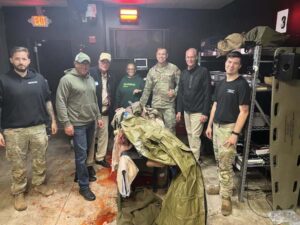
Story by Master Sgt. Gina Vaile-Nelson
Blanchfield Army Community Hospital
FORT CAMPBELL, Kentucky – Under a full October moon, four squads of civilian medical providers and medical administrators simulated Combat Casualty Care (CCC) at the Fort Campbell based Alfred V. Rascon School of Combat Medicine Oct. 17. Blanchfield Army Community Hospital leadership with the help of the 101st Airborne Division Surgeon team offered this partnership familiarization exercise to medical network partners.
The Rascon cadre developed a two-hour simulation that required the civilian guests to react to contact including direct and indirect fire; reach a casualty and provide combat casualty care; transport a casualty; and provide life-saving medical care in a field operation room. Though decades of medical training spanned the 12 network provider participants, only a handful could recall from previous military experience.
“This exceeded all expectations,” said Dr. Zachary Powers, an anesthesiologist with Tennova Healthcare in Clarksville.
A former flight-surgeon with the United States Air Force, Powers said this was his first experience with a combat simulation on the ground. “I’ve worked in-flight before, ejection burns or chemical burns, but I was excited to see how the Army does things, and how to apply MARCH (to trauma care).”
Powers and his squad assessed an injured simulated Soldier manikin in the field using the CCC’s MARCH-method of assessment: Massive bleeding, Airway, Respirations, Circulation and Hypothermia. The training comes directly from lessons-learned and throughout the Army’s involvement in combat since Vietnam.
“This training is evidence-based. What research found, was that in Viet Nam some soldiers died from non-treatable wounds,” said Dr. Michael Helwig, BACH Deputy Commander for Operational Readiness, who explained the history of CCC training to the guests. “If a Soldier was shot in the heart, or shot in the head, nothing we could do would save them. But, the vast majority of casualties in Vietnam died from extremity wounds, though we were teaching medics not to put tourniquets on. We learned we had to teach out medics better, and this training was adopted from those lessons.”
For the medical providers, the opportunity not only allowed the professionals to refresh basic trauma skills, the professionals said the experience gave them a greater appreciation for the military patients and retirees they care for through the military health network.
Dr. Anil Patel has more than 40-years’ experience as a physician and network provider to military, retirees, and their family members.
“This gives me a whole different respect for what my patients go through,” he said. “The teamwork and organization that Soldiers experience daily. This gives me a whole new line of thinking of what patients have been through already and what they go through before coming to me. It was a very rewarding experience.”